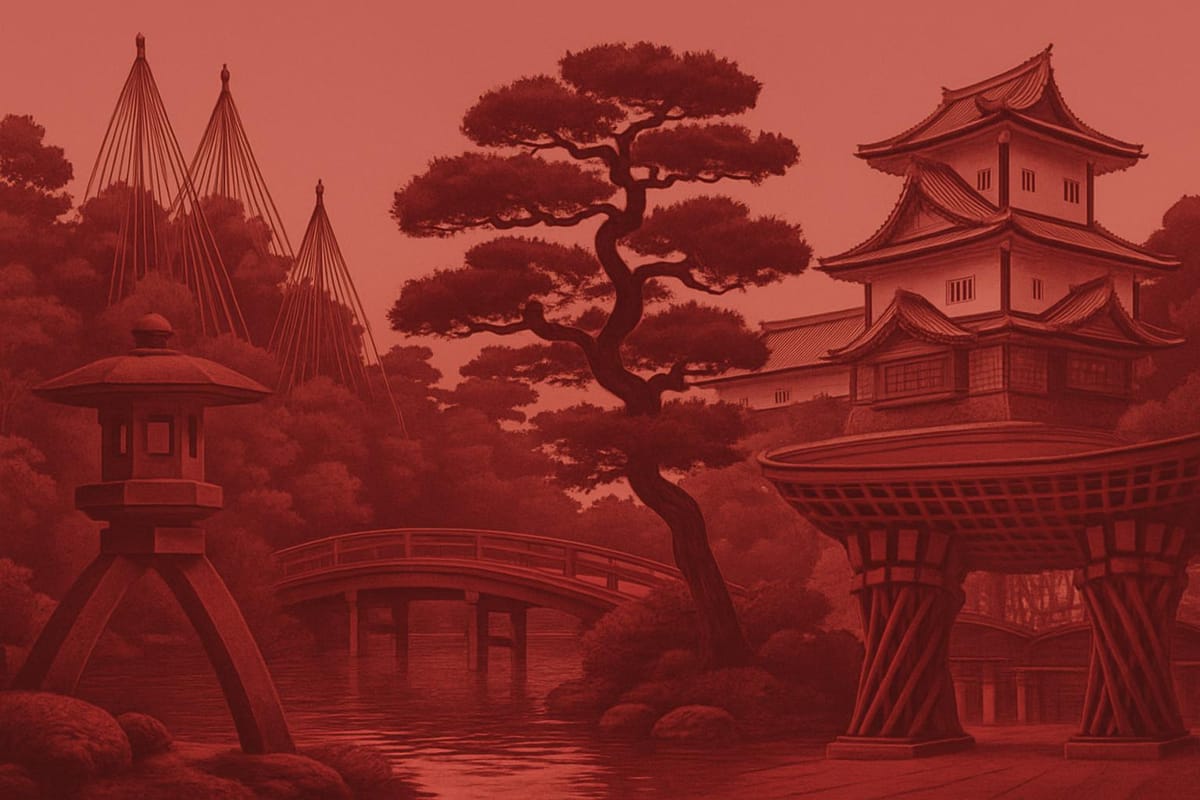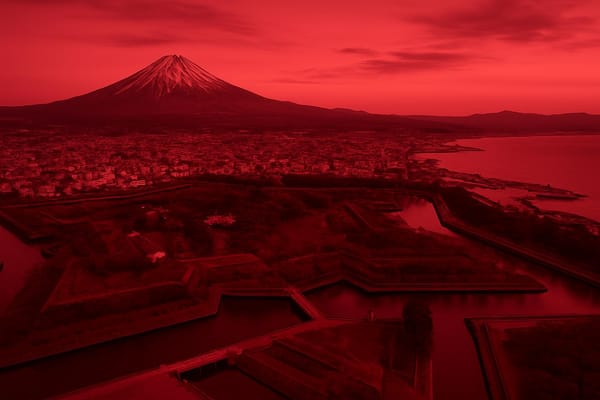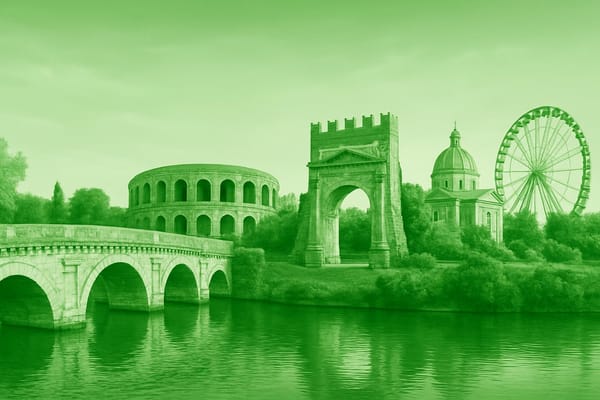Kanazawa
Discover Kenrokuen, samurai streets, historic teahouses, gold-leaf craft & fresh seafood.

Important things to know about Kanazawa
Kanazawa, a coastal city in Ishikawa Prefecture on the Sea of Japan, blends a strong sense of history with contemporary urban life, creating a living environment where traditional crafts and modern industry coexist; the city’s cultural fabric is woven from centuries-old artisan techniques, a vibrant culinary scene centered on fresh seafood, and a calendar of local festivals that reflect community rhythms rather than tour schedules. As a regional economic center, Kanazawa supports a diverse economy that includes manufacturing, education, design, and a growing creative sector, while its compact urban plan and reliable rail connections make it an accessible hub for business and study throughout the Hokuriku region. Seasonal climate patterns-cold, snowy winters and humid summers-shape everyday routines and local architecture, from insulated homes to winter-aware public services, and contribute to a year-round lifestyle that values craftsmanship, food culture, and slow living. The city’s neighborhoods mix low-rise traditional houses with contemporary residential developments and small galleries, studios, and workshops where artisans continue to practice lacquerware, gold leaf techniques, and textile arts as part of daily life rather than spectacle. Local markets, restaurants, and municipal initiatives emphasize regional produce and sustainable practices, reinforcing Kanazawa’s reputation as a place that nurtures creative entrepreneurship and culinary innovation. Whether experienced through resident-focused cultural programming, educational institutions, or the steady hum of local commerce, Kanazawa, Japan presents a balanced urban identity where modern sensibilities and time-honored craftsmanship inform how people live, work, and create.
Sightseeing hot-spots in Kanazawa
Kanazawa enchants visitors with a blend of preserved tradition and refined natural beauty, making it one of the top sightseeing destinations in Ishikawa Prefecture. At the heart of the city lies Kenrokuen Garden, often celebrated as one of Japan’s most beautiful gardens, where seasonal vistas from plum blossoms to snow-draped pines create postcard-perfect moments. Nearby, Kanazawa Castle stands as a reminder of the region’s feudal heritage, its restored turrets and stone walls offering a striking contrast to the tranquil garden paths and a compact area ideal for relaxed exploration.
Wandering through the Higashi Chaya District transports you to an atmosphere of wooden teahouses and geisha culture, with narrow lanes lined by preserved facades that invite visitors to pause for tea and crafts. The Nagamachi Samurai District complements this with earthen walls and historic residences that hint at samurai life, while numerous gold leaf workshops celebrate Kanazawa’s long-standing artisanal reputation-here you can see delicate gilding applied to everyday objects, making the city a hub for traditional crafts and souvenir shopping that captures the spirit of the region.
For modern contrasts, the 21st Century Museum of Contemporary Art offers innovative exhibitions and an accessible, circular layout that appeals to both art lovers and casual tourists, while Omicho Market tempts food-focused travelers with fresh seafood, seasonal produce, and local specialties that define Kanazawa cuisine. Together these attractions create a compact, walkable itinerary that blends nature, history, art, and gastronomy-making Kanazawa a must-see city for anyone planning Japan travel and searching for unforgettable cultural experiences.
Hotels to enjoy in Kanazawa
Kanazawa is a destination where traditional charm meets modern comfort, and choosing hotels in Kanazawa can shape your experience of this historic city. Whether you prefer a serene ryokan with tatami rooms and kaiseki meals, a boutique hotel tucked in the Higashi Chaya district, or a contemporary property near Kanazawa Station, the city offers a wide range of accommodation to suit every traveler. Many visitors prioritize proximity to Kenrokuen Garden, the 21st Century Museum of Contemporary Art, and the lively Omicho Market, so finding a hotel near these attractions can save time and let you enjoy more walking tours, tea houses, and seasonal festivals. Business travelers and families alike will find options that combine convenience with local hospitality, and several luxury hotels even provide on-site onsen baths and panoramic city views.
When searching for the best hotels in Kanazawa, consider location, amenities, and the kind of cultural experience you want to have. Booking early often secures better rates and rooms with views of the castle moat or garden, while staying close to Kanazawa Station makes day trips to Shirakawa-go and the Noto Peninsula easier. Many accommodations promote their authenticity, from modern design hotels emphasizing local crafts to traditional ryokan that offer immersive overnight stays; choose what matches your travel style and budget. For SEO-minded travelers, keywords like “Kanazawa accommodation,” “hotels near Kenrokuen,” and “best hotels in Kanazawa” are useful when comparing options, reading reviews, and planning an itinerary that highlights Ishikawa Prefecture’s culture, cuisine, and seasonal beauty.
Restaurants to try in Kanazawa
Kanazawa is a culinary treasure on Japan’s west coast, where fresh seafood from the Sea of Japan, seasonal produce from Ishikawa farms, and centuries-old techniques come together in restaurants that range from intimate sushi counters to elaborate kaiseki houses. Strolling from the atmospheric lanes of Higashi Chaya toward the bustling Omicho Market, visitors encounter marketside stalls and family-run eateries offering morning catches and regional specialties like nodoguro (blackthroat seaperch) and sweet shrimp. The city’s dining scene is defined by attention to seasonality and presentation, with chefs often incorporating local ingredients such as delicate mountain vegetables and the famous gold leaf used to finish confections and sake cups. For travelers searching for authentic Kanazawa cuisine, the balance of traditional ryotei, casual izakaya, and contemporary fusion restaurants ensures memorable meals whether you want a multi-course tasting or a quick plate paired with a glass of local sake.
Finding the right restaurant in Kanazawa rewards planning and curiosity: many of the best spots are small, require reservations, and change their menus with the harvest, reflecting the region’s deep culinary rhythms. From omakase counters where chefs craft every bite to seasonal kaiseki where each course tells a story of land and sea, restaurants in Kanazawa emphasize quality, technique, and hospitality. Wander through Nagamachi samurai neighborhoods or pause after visiting Kenrokuen garden to sample an elegant dinner, and you’ll see why food lovers put Kanazawa on their maps. For SEO-minded travelers researching “Kanazawa restaurants” or “restaurants in Kanazawa,” focusing on keywords like seafood, kaiseki, Omicho Market, and Ishikawa cuisine will help uncover the city’s best culinary experiences.
Best shopping stops in Kanazawa
Kanazawa is a delight for shoppers who crave both traditional craftsmanship and contemporary design. Strolling through Omicho Market, you’ll find stalls piled high with fresh seafood, seasonal produce and small eateries where you can sample the local bounty - a perfect place to buy edible souvenirs like dried fish, miso and specialty sweets. The city is world-famous for its gold leaf production, and many boutique shops in the center sell delicately gilded chopsticks, picture frames, cosmetics and even confectionery dusted with shimmering Kanazawa gold leaf. Lovers of textiles will want to seek out Kaga Yuzen silk, a richly dyed fabric used for kimonos and accessories, while collectors can discover hand-painted Kutani ware porcelain and elegant lacquerware from local artisans. These items make meaningful mementos and showcase the meticulous techniques that define Kanazawa’s artisanal heritage.
Beyond markets, Kanazawa’s shopping scene blends historic charm with modern flair. The atmospheric Higashi Chaya District is lined with wooden teahouses converted into specialty stores selling tea, sweets and handcrafted souvenirs, offering a tangible sense of the city’s Edo-period roots. In contrast, the Korinbo and Katamachi areas host contemporary boutiques and design shops where you’ll find minimal ceramics, stationery and innovative fashion from local designers. Many galleries and workshops provide hands-on experiences, allowing visitors to try gold-leaf application or pottery, which adds a memorable personal touch to purchases. Whether you seek fine crafts, gourmet treats or unique gifts, Kanazawa shopping delivers a rich mix of authenticity and creativity that reflects the region’s cultural depth and makes for exceptional finds.
Nightlife highlights in Kanazawa
Kanazawa nightlife unfolds like a storybook after dusk, where lantern-lit lanes and preserved wooden façades invite a slow evening stroll through the Higashi Chaya District. The air carries the hushed elegance of traditional tea houses and the occasional sighting of geisha moving between engagements, while small cafés serve gold-leaf desserts that nod to the city’s artisanal heritage. For those interested in illuminated scenery, Kenrokuen and Kanazawa Castle offer seasonal illuminations and special evening events that transform gardens and stone walls into photogenic backdrops for a romantic or reflective night out. This blend of history and ambiance makes Kanazawa nightlife uniquely atmospheric compared with larger urban centers.
As the night deepens, the energy pivots toward the lively streets of Katamachi and Korinbo where sake bars, cozy izakaya, and contemporary cocktail lounges sit side by side. Dinner options showcase Kaga cuisine and fresh seafood once traded at Omicho Market, while intimate venues host live music-from jazz to acoustic sets-creating warm spots for locals and visitors to linger. Whether you prefer bar-hopping between sake tastings or soaking in a quiet garden glow, Kanazawa’s compact, walkable center makes enjoying its nightlife effortless and memorable, blending traditional charm with modern evening pleasures.
Getting around in Kanazawa
Kanazawa offers convenient and well-integrated airport and train connections that make it an attractive hub for travelers exploring the Hokuriku region; most air travelers use Komatsu Airport, located roughly 30–40 minutes from the city center by direct airport bus or taxi, while seasonal international charters supplement regular domestic links to Tokyo, and shuttle services coordinate with major flight arrivals to JR Kanazawa Station, the city's rail heart. Since the opening of the Hokuriku Shinkansen, Kanazawa enjoys fast, reliable direct access to Tokyo and excellent connections to nearby cultural destinations, with high-speed services such as the Kagayaki and frequent limited-express trains linking to Osaka, Kyoto and the Noto Peninsula; inside the city, the modern station is a multimodal hub where local buses, trams and tourist shuttles meet, making trips to Kenrokuen, the Nagamachi samurai district and Higashi Chaya simple and efficient. For visitors focused on smooth transfers, airport shuttles, frequent train timetables, luggage delivery and clear signage help minimize transit stress, while integrated ticketing options and multilingual support at major stations enhance accessibility, so planning routes around train schedules and shuttle departures ensures the best use of time for sightseeing or onward travel.
Culture must-see's in Kanazawa
Kanazawa, Japan, is a city where the past and present meet in graceful harmony, and its cultural highlights draw visitors searching for authentic Edo-period ambiance and refined aesthetics. The crowning jewel is Kenrokuen, one of Japan’s most celebrated landscape gardens, whose seasonal beauty frames views of Kanazawa Castle and tranquil ponds dotted with traditional pavilions. Wandering the Nagamachi samurai district reveals earthen walls and narrow lanes that evoke feudal life, while the historic Higashi Chaya geisha quarter offers lacquered tea houses, live performances, and the chance to step into a working teahouse where centuries-old customs remain alive. Kanazawa’s long association with gold leaf production means gilded crafts and culinary touches appear everywhere, and local specialties like Kutani ware ceramics and Kaga lacquerware testify to a persistent devotion to artisan skill.
Beyond historic streets, Kanazawa’s cultural appeal extends into contemporary and culinary realms: the 21st Century Museum of Contemporary Art challenges expectations with innovative installations, and intimate gallery spaces showcase regional artists inspired by Kanazawa’s heritage. Food culture here is equally distinctive, with Kaga cuisine emphasizing fresh seafood, seasonal vegetables, and delicate presentations that reflect the city’s aesthetic values; tasting menus often incorporate local gold leaf as a decorative flourish. Visitors can join workshops to learn traditional crafts, attend a formal tea ceremony, or time a trip for festivals that animate shrines and neighborhoods. Together, these cultural highlights make Kanazawa a compelling destination in Japan for travelers who seek history, art, and hands-on experiences deeply rooted in place.
History of Kanazawa
Kanazawa’s history is a layered tapestry of political power, artistic achievement, and urban resilience that dates back to its emergence as a fortified settlement in the late medieval period. Under the rule of the Maeda clan during the Edo period, the city became the center of the wealthy Kaga Domain, often described as the “million-koku” domain for its immense rice revenues. That wealth fostered an extraordinary flowering of culture: samurai districts and merchant quarters developed alongside refined arts such as gold leaf production, lacquerware, and textile dyeing. The creation and preservation of Kenrokuen, one of Japan’s most celebrated gardens, exemplifies how political stability encouraged aesthetic cultivation. Neighborhoods like Nagamachi with its samurai residences and Higashi Chaya with its teahouses and geisha culture still retain the atmospheric streetscapes of the Edo era, and these historic areas play a central role in any narrative about the history of Kanazawa. During the Tokugawa shogunate, the city’s isolation from the political turmoil of the capitals allowed local craftsmen and tea masters to refine techniques and rituals, embedding the practice of the tea ceremony and other traditions into daily life and civic identity.
The transition from feudal rule to modernity in the Meiji era did not erase Kanazawa’s past; instead, it prompted new preservation efforts that have made the city a living museum of Japanese heritage. Despite modernization and 20th-century challenges, Kanazawa avoided the widespread wartime destruction that befell many other urban centers, so much of its historic fabric survived and remains vibrant today. Contemporary attractions like the 21st Century Museum sit alongside centuries-old temples, markets, and craft shops, illustrating how innovation and tradition coexist in the city’s ongoing story. Tourism, cultural festivals, and a renewed global interest in traditional crafts have furthered economic revitalization while encouraging careful conservation. For anyone researching Kanazawa or planning a visit, the history of Kanazawa is more than chronology; it is an active, visible heritage where samurai-era layout, artisanal excellence such as gold leaf and Kutani ceramics, and living practices like the tea ceremony continue to shape local identity and attract cultural travelers seeking an authentic Japanese experience.



